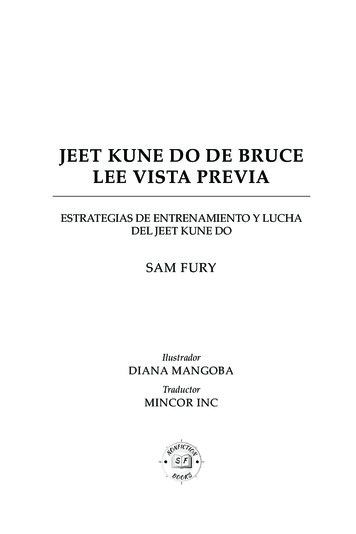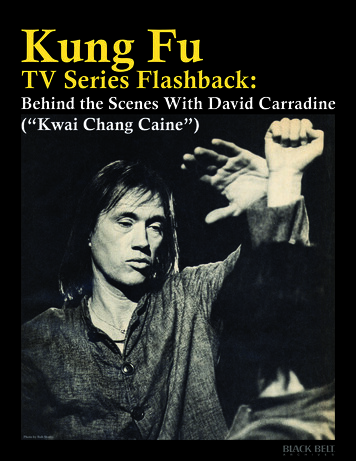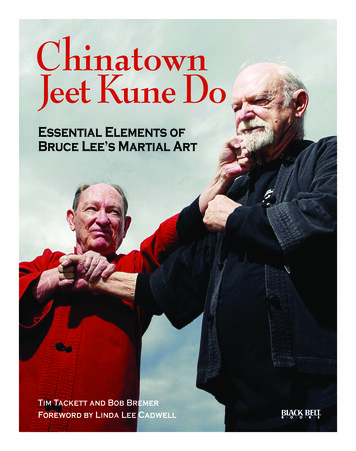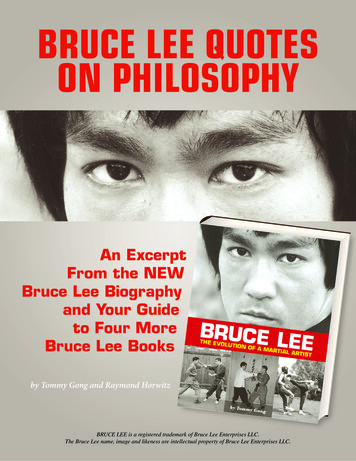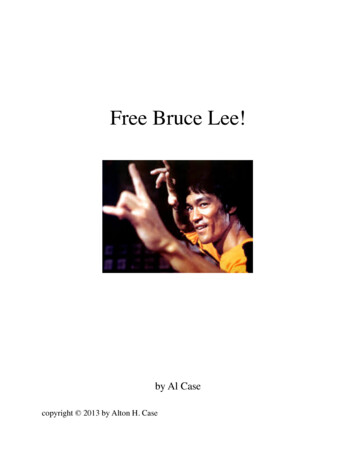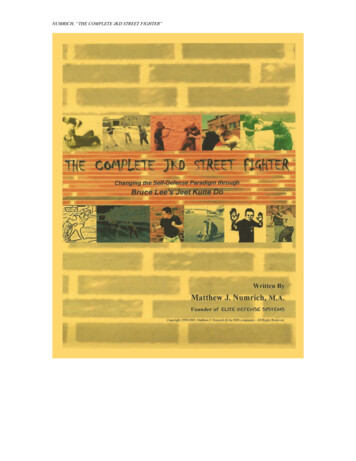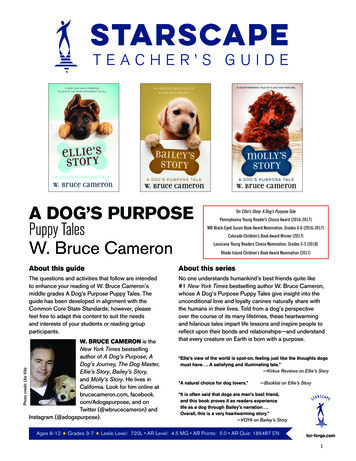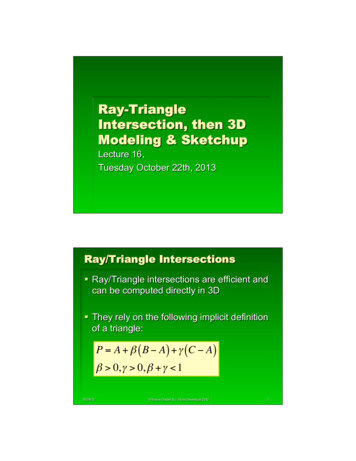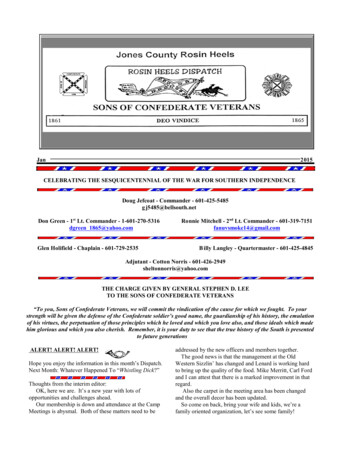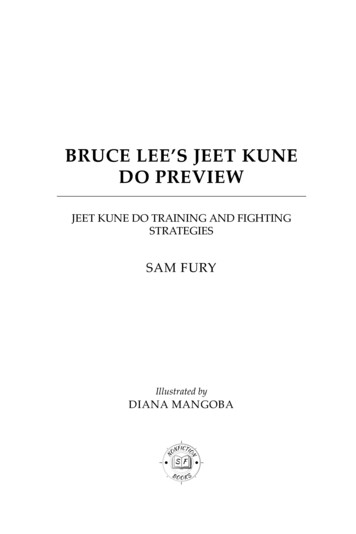
Transcription
BRUCE LEE’S JEET KUNEDO PREVIEWJEET KUNE DO TRAINING AND FIGHTINGSTRATEGIESSAM FURYIllustrated byDIANA MANGOBA
Copyright Sam Fury 2015www.SurvivalFitnessPlan.comAll Rights ReservedNo part of this document may be reproduced without written consent from the author.
WARNINGS AND DISCLAIMERSThe information in this publication is made public for referenceonly.Neither the author, publisher, nor anyone else involved in theproduction of this publication is responsible for how the reader usesthe information or the result of his/her actions.Consult a physician before undertaking any new form of physicalactivity.
CONTENTSIntroductionJeet Kune Do ConceptsHow to Use This Book to Train in Jeet Kune DoOn Guard PositionBalanceFootwork and DistanceShuffleLead Straight PunchTarget k StepsSparringStrategic Fighting OverviewStrategy in DistanceSingle Angulated AttackTimingLead Finger JabDropping the HammerSnapback
viCreating OpeningsStop HitLead JabLow Lead Side-KickStop KicksPendulum StepCirclingBack-fistHook KickFront KickInside KickMedium Side-KickBurstSliding LeverageAttack by CombinationRear Straight PunchHook PunchDuckingBob and WeaveRenewing the AttackLead Straight to the BodyRear Straight to the BodyUppercutRollingContents
ContentsShovel HookVertical HookImmobilization AttackChi SaoElbows and KneesPressingSelf-Defense Scenarios/Instinctive TrainingProgressive Indirect AttackAttack by DrawingBeatSpin KickSweep KickBonus MaterialsAuthor RecommendationsSurvival Fitness Plan Training ManualsAbout the Authorvii
INTRODUCTIONIt is my belief that Bruce Lee intended Jeet Kune Do (JKD) to be aframework to be built upon in order for an individual to develop away of fighting that works best for him-/herself.Inside this book are lessons which focus on the base concepts andtechniques that Bruce Lee developed for JKD. This could be inter‐preted as Bruce Lee’s JKD, but what works for Bruce may not workfor you, and what works for you may not work for me.Use the lessons in this book as a base to create your own JKD. Onceyou understand them, you’ll be well equipped to analyze any tech‐nique from any other source and decide if it will be useful to you. Ifit’s not, get rid of it. That includes techniques in this book that youfeel don’t benefit you.Learning many techniques is not what’s needed to be a good fighter.It is far better to be very good at just a few than just okay at many.The key is to shed that which is not good for you.The more techniques you have in your arsenal for a certain situa‐tion, the more you have to choose from. It takes time to makechoices, and the more there are, the longer it takes.It’s far better to have one technique that you know works in a givensituation, and then drill that into your muscle memory, so you’llmove instinctively if/when that situation comes up.When you have these techniques ingrained in your muscle memory,you won’t have to think about reacting in certain situations and yourmind will be free to strategize.You need to experiment to find the best technique for a given situa‐tion. That’s what training is for. When choosing a technique, keep tothe main JKD principles/concepts.This book focuses on the physical techniques and mental strategiesof fighting and does attempt to explore the philosophical or spiritual
xIntroductionside of JKD. Bruce Lee’s Tao of Jeet Kune Do is, in my opinion thebest source for anyone interested in that side of JKD, and is highlyrecommended even for those who are not.
JEET KUNE DO CONCEPTSI recommend that you read this chapter before starting the lessons inthis book so you can get a feel for the main concepts of Jeet KuneDo. Some of these concepts are also discussed in greater detail aspart of the lessons. Like everything in this book, treat these things asguidelines to be adhered to most of the time, not strict rules set instone.Lead Straight Punch“The leading straight punch is the backbone of all punching inJeet Kune Do.”Bruce Lee.The lead straight punch is designed to be fast, accurate, powerfuland extremely practical. A lesson is dedicated to the lead straightpunch.Non-Telegraphed AttacksTelegraphing an attack is when you do something that alerts youropponent to your attack, such as pulling your hand back beforepunching, looking at your intended target, or making a slight facialmovement.When you can initiate your attack without any forewarning, youropponent will have less time to react.Jeet Kune Do (JKD) attacks are meant to be thrown with no signs ofpreparation, but even this is not set in stone. An example may bewhen you have your opponent’s arms pinned. Pulling your arm backwill produce more power, and because you have his/her armspinned, telegraphing the move may not matter.
2S A M F U RYNon-ClassicalEvery situation is different, and to be successful, you must be able toadapt. Being set in a particular style of martial arts and their clas‐sical forms can restrict you as a practitioner.“Empty your mind, be formless, shapeless, like water. If you putwater into a cup, it becomes the cup. You put water into a bottleand it becomes the bottle. You put it in a teapot it becomes theteapot. That water can flow, or it can crash. Be water, my friend.”Bruce Lee.Furthermore, many of the traditional forms are designed to lookgood rather than to be effective. In JKD, effectiveness is whatmatters.Economy of MotionEconomy of motion is minimizing the waste of time and/or move‐ment. A good attack reaches its target in the least amount of timewith as much force as possible. This saves you energy and alsomakes your attack faster, giving your opponent less time to react.DirectnessYour attack should take the shortest possible route to its target, whileyou stay safe from your opponent’s attack. This is usually a straightline.Your Longest Weapon to the Closest TargetUsing your lead hand or foot to the closest target results in yourattack traveling the shortest distance possible, which means youropponent has less time to react. An example of this is the low leadside-kick to the shin or knee.
Bruce Lee’s Jeet Kune Do Preview3SimplicityDo not complicate things. Only do as much as is needed to achieveyour objective as quickly as possible.“Simplicity is the shortest distance between two points.”Bruce LeeSimultaneous Defense and OffenseIn many of the fighting arts, when an attack comes in, the practi‐tioner defends and then returns with an attack of his/her own (acounterattack). It’s one after the other. With simultaneous defenseand offense, when the attack comes in you defend and counter at thesame time. This saves time and is harder for your opponent todefend against.A counterattack is a tactic employed in response to your opponent’sattack. In this book, it’s also referred as a counter, countering, etc.InterceptionInterception goes one step further than simultaneous defense andoffense by making the defense and offense one movement. You stopyour opponent’s attack with an attack of your own. In other words,you intercept his/her attack.The two main tools for doing this are the stop hit and sliding lever‐age, which are explained in detail in their respective dedicatedlessons.Jeet Kune Do literally translates to “The Way of the InterceptingFist.”
4S A M F U RYFour Ranges of CombatThere are four basic ranges that you can be in relative to your oppo‐nent and the attacks that can be made. You must know how to effec‐tively fight in all of them. The ranges are kicking, punching,trapping and grappling.Five Ways of AttackAlthough presented separately, the five ways of attack work togetherand are very much intertwined. What follows is a very basic over‐view. Each way of attack will be discussed in detail in the lessons.Single Angulated Attack (SAA)A single attack directed at the target using the most economicalroute possible. It’s hitting your opponent before he/she can respondeffectively. It relies on speed and timing.Attack by Combination (ABC)An attack made up of two or more movements that preferably blendtogether naturally.Immobilization Attack (IA)Trapping or immobilizing your opponent’s limb(s) so you can eitherdirect it/them out of your attack line or keep it/them from moving.Progressive Indirect Attack (PIA)Using a feint or other movement to create an opening and thenstriking in the same movement. You do not withdraw your limb tomake the strike.
Bruce Lee’s Jeet Kune Do Preview5Attack by Drawing (ABD)Exposing a target in order to entice your opponent to attack. Whenhe/she is committed to an attack you intercept or defend andcounter.CenterlineThe following is an excerpt from Basic Wing Chun Training by n-TrainingThe centerline principle is a core concept in Wing Chun kung fu.Most, if not all, of the exercises in this book are focused onprotecting your own centerline while controlling your opponent’s.Your centerline is an imaginary line drawn vertically down thecenter of your body. All the vital organs are located near the centerof the body. Keep it away from your opponent by angling it awayfrom him/her.Controlling the position of your centerline in relation to your oppo‐nent’s is done with footwork. Understanding the centerline will allowyou to instinctively know where your opponent is.
6S A M F U RYYour central line (different from your centerline) is drawn from yourangled center to your opponent.Offensively, you generate the most power when punching out fromyour center, since you can incorporate your whole body and hips.When you’re attacking in a straight line, your centerline should faceaway from your opponent, while your central line faces his/hercenter.With hook punches and other circular attacks, the center- andcentral lines merge.
Bruce Lee’s Jeet Kune Do PreviewThere are three main guidelines for the centerline.The one who controls the centerline will control the fight.Protect and maintain your own centerline while you controland exploit your opponent’s.Control the centerline by occupying it.7
HOW TO USE THIS BOOK TO TRAIN IN JEETKUNE DOHow often and how long your training sessions run depends on thetime you have available and the time you’re willing to spend. As witheverything, the more you train, the faster you’ll progress. A sampletraining schedule is included in the bonuses.Warm-upAlways begin your training session with a warm-up and light stretch‐ing. Not warming up before putting the body through strenuousactivity will result in injury.The length of time you spend warming up depends on your bodyand the temperature. The cooler the temperature, the more timeyou will need to warm-up.Skipping RopeSkipping rope for three to five minutes is usually sufficient to warmup. Skipping will also help you develop a sense of balance and theability to be light on your feet.
Bruce Lee’s Jeet Kune Do Preview9Longer skipping sessions can be used to increase cardiovascularstamina. Ten minutes of skipping rope has the same cardiovascularbenefits as thirty minutes of jogging.To get the most out of skipping, add some variety, such as holdingone foot out in front of you while skipping on the other, alternatingfeet with each turn of the rope, varying the speed at which you skip,etc. Use your wrists to swing the rope as opposed to your arm.A leather rope with ball bearings in the handles is the best kind ofskipping rope to use.ShadowboxingShadowboxing is another good warmup activity which helps buildstamina, speed, muscle memory, footwork, creation of ideas, etc.When you do it, imagine an opponent in front of you and get your‐self into a fighting frame of mind. Start slow and relaxed, concen‐trating on form. Build up speed as your body warms up.Focused ActivitiesSkipping rope and shadowboxing are good for warming up the bodyas a whole, but you must also pay special attention to the actions youplan to do during the training session and imitate them during thewarmup. For example, if you will be practicing the side-kick, thendo some light kicking before attempting to do it with more power.StretchingLight stretching is also needed as part of your warmup. Deepstretching is done after your workout.SkillsWork on technical skills immediately after your warmup. Technicalskill drills are best done while you’re fresh. If you do them when
10S A M F U RYyou’re fatigued, you’ll probably not do them properly, and how youtrain will be reflected in the way you fight. When you start gettingexhausted, switch to more endurance-based training.Progressive LearningEach chapter in this book can be considered a lesson, and all thelessons build on each other. It is advised that you not skiplessons/chapters, at least not the first time you go through them.Repeating lessons is encouraged, including during your first runthrough.Each lesson focuses on one skill or stratagem. It is intended that thefocus of your training session will be on that lesson, but you shouldincorporate and adapt what you have previously learned, includingvarious training exercises, where appropriate. Everything in fightingis intertwined and works together!Practice everything on both sides of your body—that is, from a rightand left lead stance. Spend as much time as you need on eachlesson. Sometimes you may wish to spend a whole training sessionon one lesson, and other times, you might do multiple lessons in asession.When you’re learning something new, it’s important that you first doit slowly to get the correct technique. After you have the technique,you can work on other things, such as speed, power, using the tech‐nique with other movements, etc. Revisit a technique regularly toperfect it.Here are some different methods for practicing a new movementonce you have a good grasp of correct technique. They are by nomeans the only ways. Training methods are only limited to imag‐ination.Increase speed and power in the air while standing still.Use the technique with footwork and/or evasive*movements.
Bruce Lee’s Jeet Kune Do Preview11Practice the technique by striking something, such as paper,a punching bag, or punching pads.Practice striking a moving target, such as a partner movinga hand pad or a light ball hanging from the ceiling.Practice doing a movement in response a stimulus (whensomeone claps, for example).Have a partner reveal a punching pad as he/she movesaround (good for training your perception and response.)Do the movement with parries, as a counter, incombination, etc.Incorporate the movement in shadowboxing.Have one person attack while the other defends.Practice the movement/strategy while sparring.In the spirit of Jeet Kune Do, find what works best for you anddiscard what doesn’t. Use your training to experiment with what youlearn. When you discover things that work well, train in them moreoften, as these are the things you’ll want to use in a real fight.*An evasive movement is one in which you use your body to moveaway from an attack. Unlike blocking or parrying, it doesn’t involveany contact. Ideally, your evasive maneuver will cause the attack tomiss you by as little as possible and keep you in range to coun‐terattack.SparringSparring is the closest thing you can do to actually fighting, and it isintroduced as a lesson as soon as some of the basics have beencovered. Once you’ve done the lesson on sparring, make it a regularoccurrence. Use sparring to test what you learn on a reactive oppo‐nent. Having some sparring time in every training session is recom‐mended, and you may even want to have whole sessions with justsparring.
12S A M F U RYFitnessJeet Kune Do stresses the importance of personal health and fitnessmore than many other martial arts. Having separate trainingsessions dedicated to increasing fitness is recommended. The crosstraining will also allow you to learn different skills and preventtraining slumps.Skipping has already been mentioned as a good fitness activity. Evenjust three 3-minute rounds of skipping with 30 to 60 second breaksin between can make for a good workout.Intense sparring is also good for fitness.Things like running, cycling, rock climbing, parkour, swimming, etc.are good for fitness, and you will be learning/practicing skills thatmay prove very useful. Survival Fitness by Sam Fury is a good sourceof information for training in these tnessMost team sports are also great for fitness, especially those requiringshort bursts of running such as soccer (football), basketball, etc.Muscle conditioning must also be worked on. It can be done withonly bodyweight exercises, or you may prefer to use weights. Ifyou’re working with weights, remember that heavy weights will buildmass (bulking up), whereas lighter weights will build density (carvingthe muscles or “getting ripped”).To increase endurance, you need to train until you’re exhausted.Use fartlek-style training, in which you intersperse moderate-inten‐sity exercise with high-intensity bursts. For example, if you go for a30-minute jog, then put in a ten-second sprint every two minutes.Stretch/CooldownEnd every training session with a cooldown. A cooldown is a lightversion of a warmup followed by a deeper stretching. How long
Bruce Lee’s Jeet Kune Do Preview13your cool down is up to you. It should be at least as long as it takesfor your heart rate to return to normal.Training for RealityIt is important that you train the way you’ll fight, because what youdo in training will be ingrained in your body. If you punch incor‐rectly and/or with no effort during training, then you’ll essentiallybe teaching your body how to punch in a less effective or incorrectway. Everything you do should be done with 100% concentratedeffort. When hitting a pad or in the air, imagine an opponent andwhat part of them you’re aiming at.If you want to become fast, you have to train with fast movements.This doesn’t mean you should overexert yourself and tense up; that’sawkward and produces bad technique. Instead, you must be relaxedwith smooth movements.If you’re learning for self-protection, train most in the techniquesthat are most effective. During sparring, you can figure out whattechniques work most often for you.Indoors vs OutdoorsWhen you need to use certain equipment or need a controlled envi‐ronment to practice technical skills and the weather is bad, it’s betterto train indoors. For everything else, train outside, regardless of theweather. In a real fight, it may be hot, cold, very bright, foggy, rain‐ing, etc. Only by actually training in these circumstances can you getused to them.
ON GUARD POSITIONThe On-Guard position (OGP) is an effective fighting stance thatallows you to be balanced during movement. It is a perfect stancefrom which to attack and defend without telegraphing.Wide stances found in many traditional martial arts are good forstability, but limit mobility and often leave target areas open. Anarrow stance, such as those used in boxing, is good for mobility butlacks stability and leaves the groin and other low target areas open.The On-Guard position is both stable and mobile and is designed toprotect all major target areas.Lead and Rear SidesYour lead side (leg, foot, arm, hand) is whichever side you putforward most. Your rear side is the side that is not your lead.When you adopt the OGP, your dominant side is your lead most ofthe time. Since your lead arm and leg are closest to your opponent,you’ll use them for most of your strikes. Having your dominant sideas your lead means that the majority of your strikes will be fasterand stronger.Striking with your lead will never be as powerful as striking withyour rear because you’ll have less momentum, but the speed advan‐tage gained is worth the tradeoff. In training, work hard onimproving power from your lead arm and leg.Although your lead is mainly for striking and your rear is mainly fordefense, there are no hard rules, and you’ll often need to defend andattack with either hand.In attack, your lead is best used for speed and your rear for power.When you’re attacking with one hand, you should be using the otherto protect your body or doing some other defensive maneuver, such
Bruce Lee’s Jeet Kune Do Preview15as pinning your opponent’s arm. You also need to have your defen‐sive hand ready to perform a follow-up strike.Although your dominant side is your main lead and the one youshould default to in real situations, train on both sides, taking turnsbetween left and right leads. This will ensure body balance and willalso prepare you in case you’re unable to use your dominant side asyour lead because of injury or other circumstance.These pictures are from a right lead.Matched and Unmatched LeadsWhen both you and your opponent have the same lead, it’s referredto as a matched lead. If you have different leads, it’s called anunmatched lead.If you have an opponent with an unmatched lead, place your leadfoot slightly to the outside of your opponent’s lead foot. This putsyou outside his/her guard, which gives you more time to react tohis/her movements. It also keeps you away from your opponent’srear arm and leg.
16S A M F U RYLower BodyThe OGP is a semi-crouched position.Stand naturally with your feet shoulder-width apart, then take anatural step forward with your dominant foot. If needed, adjustyour feet so they’re a little wider than shoulder width apart. Keepyour knees slightly bent. Your knees and elbows should never belocked straight when you’re fighting.Keep your lead knee fairly straight and turn it slightly inward toprotect your groin. In order for you to stay light on your feet, yourlead heel has only light ground contact.Your torso should form a straight line with your lead leg. The posi‐tion of your lead foot will determine the structure of your torso.What you do depends on your intention. If your lead foot is turnedinward, it will give you a narrower profile, which is good for defense.Some attacks will require a wider profile, so you’ll need to turn yourfoot outward. In a neutral stance, have your lead foot at a 25 to 30 angle.Place your rear foot at a 45 to 50 angle, with your heel raised.The raised heel enhances mobility. It will allow you to shift yourweight when you’re advancing, as well as for some give when you’redefending.
Bruce Lee’s Jeet Kune Do Preview17Place your feet directly under your body. When you’re in a neutralposition (neither attacking nor defending), your weight should bespread evenly over both legs, or slightly more over your lead foot.To put more weight on your lead, just bend your lead knee a littlemore.Upper BodyHold your lead shoulder slightly raised with your chin slightlylowered to protect it. Your chin and lead shoulder should meetabout halfway.Use your hands help to protect your face and groin. Keep your leadhand just below shoulder height, and your rear hand approximatelyat chest height, about five inches away from your body.Hold your elbows close to your body to protect your torso. Theymust remain relaxed but sturdy—you can move them side to side ifneeded, but you should be able to withstand an attack withouthaving them collapsing in toward your body.Keep your head mobile to avoid getting hit. When fighting in close,you can tuck the side of your chin into your shoulder for moreprotection. In extreme defense, tuck the point of your chin to yourshoulder.Keep your back relaxed and partially contract your stomachmuscles.The OGP is a non-rigid stance. Be relaxed in position, with yourhands and body in constant light motion, while keeping your bodycovered. Curved motions are more energy efficient than straightlines (if you have to change direction suddenly, for example), but donot overdo them, and do not unnecessarily shift your weight fromone foot to the other.You may need to learn to keep your body relaxed. Do this withconscious effort until you can gain the feeling at will. You will thenbe able to induce this attitude in tense environments.
18S A M F U RYThe instructions above describe how to adopt the OGP in general.However, everything is dependent on the situation you are facedwith.Check your OGP in the mirror to ensure you’re relaxed, with noopenings. When practicing different techniques launch them fromthe OGP and return to the OGP as soon as possible. When investi‐gating the use of techniques from other sources, use those that areconducive to the OGP.
LEAD STRAIGHT PUNCHThe lead straight punch is a fundamental technique of JKD andmany very important lessons stem from it. It has been designed to befast, accurate, powerful and extremely practical.Eventually, you want to be able to throw the straight punch (lead orrear) from any position that your hand happens to be in at any giventime and without telegraphing your intention.Forming a FistKnowing how to form a proper fist is essential in order to punchwithout injuring yourself.Hold your hand out flat, with your fingers together and yourthumb up.Roll your fingers into your palm and then bring your thumb downover your fingers.Conditioning your knuckles will make your punches stronger andhelp to prevent injury in the future. Doing push-ups on clenched
20S A M F U RYfists is a good way to start. Do them with the knuckles from your twosmallest fingers making contact with the floor and your palms facingeach other. This exercise has the added benefits of conditioningyour muscles and ensures your wrists are in proper alignment withyour forearms.Delivery of the Lead Straight PunchStand relaxed in the OGP. During the delivery of the punch, keepyour rear hand up ready for defense and/or counter-attack.Use your whole body to generate power.The power comes up from the ground and through your hips, with atwist on the ball of your foot. Whip your hand straight out in frontof your nose, moving from the center of your body.To prevent telegraphing, start your hand moving first.Ideally, the point of contact for the lead straight will be in line withthe surface of your shoulder. If your target is lower or higher thanthis height, adjust the height of your shoulder-line to match. Crouchor stand on the balls of your feet, as appropriate.Keep your elbow in and close to your body. This helps with protec‐tion and also minimizes telegraphing.As with all hand strikes, shift your weight slightly over your front leg.This increases power and speed.As your strike makes contact, snap your wrist and clench your handinto a vertical fist, with your thumb up and knuckles pointed towardyour target. Your fist must be aligned with your forearm and notbent down at the wrist.As you snap your lead, draw your rear hand suddenly towards yourbody. The bottom three knuckles should make contact as you punchthrough your target.
Bruce Lee’s Jeet Kune Do Preview21With all strikes, it is important that they end with a snap a fewinches behind your target. In a snap, you’re striking through youropponent, not pushing.The pivot of your hips, the snap back of your rear hand and otherbody movements help to increase power in the lead straight, but alsohelp telegraph your punch. Against a fast opponent, you may haveto sacrifice some power to increase the speed of the punch.Allow your arm to come back naturally to the OGP. This will prob‐ably be in an elliptical shape, but may be straight back depending onyour posture. The important thing is not to let it drop down andleave an opening.The whole punch is a continuous motion.Keep your body upright and balanced throughout the movement.Leaning back will negate power. If you do lean back while fightingto avoid getting hit, ensure that you reposition your body beforepunching.
22S A M F U RYLeaning too far forward will cause you to become unbalanced. Youmust be committed to your strike, but not reach so far so that yourbalance is compromised. Overreaching is usually a result of beingtoo far away from your target. Use your footwork to close thedistance, not the lean of your body. This applies to all strikes.Trying to put too much body weight behind the punch will alsoreduce power. It will turn the punch into a push, which may moveyour opponent back, but will not have anywhere near the samedevastating impact as a whip-like punch.Never initiate a strike with a foot off the ground.In relation to reach, a short or long lead straight can be used. Theextension in reach is made by extending your shoulder into thestrike. Use your whole reach whenever possible.Developing RelaxationBeing relaxed is very important to producing speed and power. Asimple exercise to develop a relaxed arm is to get someone to holdyour arm in position. Give him/her the full weight of your arm.Gradually increase the tension until you have just enough to holdyour arm up. Notice how relaxed your arm is. This is how relaxed itshould be before initiating a strike.Concurring and Overlapping CirclesAs you strike, the power comes in the form of a series of circularmotions. In order to use your whole body to generate power, youjust need to imagine a centripetal force (a force that makes a bodyfollow a curved path) flowing through your body from theground up.Your first movement starts with the turning of your rear ankle. Thissets the body in motion.The next circle is at the lead knee, followed by the waist, then thelead shoulder, then the lead arm, and finally the lead wrist.
Bruce Lee’s Jeet Kune Do Preview23All these circles happen almost instantaneously, and with increasingspeed from one to the other. Your punch reaches its destinationbefore the first circle stops, and the last motion of your wrist is thefastest.Using Your HipsLearning to use your hips properly will help you develop power inyour strikes.Hang an A4 sized piece of paper from the ceiling so it’s about chestheight. Stand about eight inches away, with both your feet parallelto it. Have your hands in front of your chest and let your elbowshang relaxed. Keep your eyes on the target while you twist in aclockwise direction on the balls of your feet. End at a 90 angle tothe
JEET KUNE DO CONCEPTS I recommend that you read this chapter before starting the lessons in this book so you can get a feel for the main concepts of Jeet Kune Do. Some of these concepts are also discussed in gr

